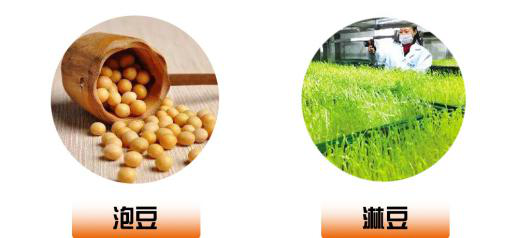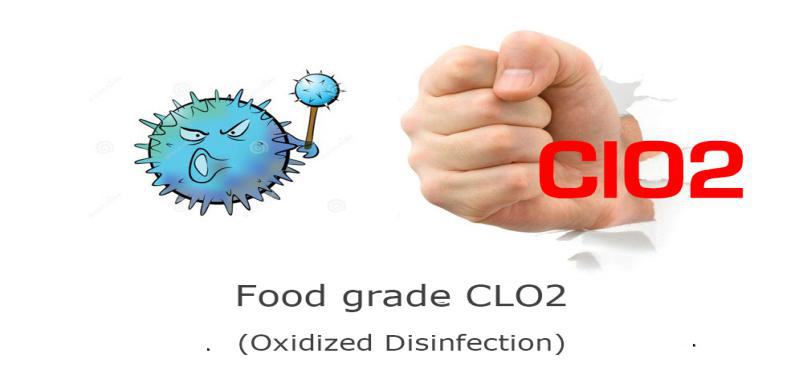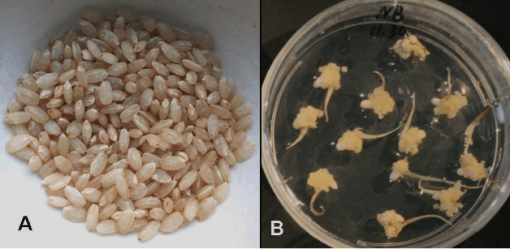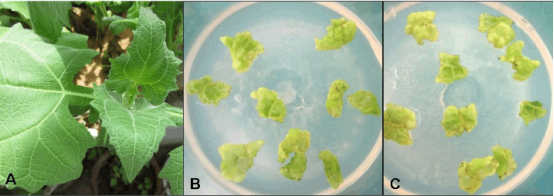Application of food-grade disinfectant chlorine dioxide in the disinfection of plant explants

Abstract: The surface disinfection of explants is the first step in plant tissue culture for the test materials to become sterile. The currently commonly used disinfectants mercury chloride and sodium hypochlorite have certain drawbacks, so it is very important to explore new disinfection methods for plant explants. In this paper, chlorine dioxide disinfectant is used as the research object to investigate its application potential in disinfection of explants of cereal crops rice seeds, herbaceous plants yacon and woody plant pomegranate. The results showed that treatment with 80.0—133.0 mg/L ClO2 had a better disinfection effect on rice seeds, with a cure rate exceeding 90%, and the quality of the induced callus was better; after treatment with 28.6—33.3 mg/L chlorine dioxide on the young leaves of yacon The wound tissue induction rate is close to 80%, which is similar to the result of 0.1% HgCl treatment. In the disinfection test of pomegranate, after 25to400mg/L chlorine dioxide treatment, the young leaves were all decolorized and browned and died, while the material of the 0.1% HgCl treatment group grew well, but when the chlorine dioxide was less than 80%, part of the pomegranate material was contaminated . As a new environmentally friendly disinfectant, chlorine dioxide has the potential to replace 0.1% HgCl in the disinfection of certain plant explants

Chlorine dioxide has strong selectivity when reacting with organic and inorganic substances, and does not produce divergent organic halides (TOX) and carcinogenic trihalomethanes (TMH). Therefore, the World Health Organization (WHO)
It is recommended that chlorine dioxide is a grade A1 product among the safe disinfection substances
There are many studies on the application of chlorine dioxide in drinking water disinfection, agricultural production, aquatic product processing, fruit and vegetable preservation, and food industry. However, there are not many reports on the application of chlorine dioxide to the disinfection of explants in plant tissue culture.
1Materials and methods
1.1 Experimental materialsGrass plant rice seeds; herbaceous plant yacon seed shoots; woody plant pomegranate seedlings. carbon dioxide. Mercury chloride.
1.2 Experimental method
1.2.1Chlorine dioxide disinfectant preparation
Dissolve 1 tablet A in 50ml sterile water, add 5mlB agent after it is completely dissolved, cap the bottle immediately, and add sterile water to 500ml after 5 minutes to obtain the chlorine dioxide disinfectant stock solution (400mg/L) . Dilute the original solution by a series of multiples to prepare different concentrations of chlorine dioxide disinfectant (now equipped for current use). The specific concentrations are as follows: 1 times (200.0mg/L), 3 times (133.0mg/L), 5 times (80.0mg/L), 7 times (57.1mg/L), 9 times (44.4mg/L), 10 times Times (40.0mg/L), 12 times (33.3mg/L), 14 times (28.6mg/L), 16 times (25.0mg/L).
1.2.2 Pretreatment of experimental materialsPick full, disease-free, and intact embryos of rice seeds for surface disinfection experiments; yacon and pomegranate tender leaves are rinsed with running water for 30min, and sterile filter paper absorbs surface moisture before disinfection experiments .
1.2.2 Explant disinfection method
Paddy rice seeds were soaked in chlorine dioxide solution of each concentration tested for 25min (shaking occasionally during the period), and then inoculated to callus induction medium NB (Duanet al., 2012) after absorbing the surface water. Inoculate 20 seeds in each petri dish. After pretreatment, the young leaves of yacon are soaked in chlorine dioxide solution of various concentrations for 25min (shaking occasionally during the period), and then inoculated on callus induction medium (MS+2,4-D2.0mg/L) after absorbing the surface water. + Sucrose 30g/L+ agar 7g/L, pH5.8) medium, each flask was inoculated with 10 explants. After pretreatment, pomegranate shoots are soaked in chlorine dioxide solution of various concentrations for 25min (shaking occasionally during the period), and then inoculated on callus induction medium (MS+NAA0.5mg/L+6BA). 1.0mg/L+sucrose 30g/L+agar 7g/L, pH5.8), each culture flask was inoculated with 10 explants. In each of the above experiments, the control group was soaked in 0.1% mercuric chloride solution for 6min, rinsed with sterile water for 5 times, sucked up the water, and inoculated into the corresponding medium. The number of inoculation was the same as that of each experimental group. Each treatment was repeated 3 times. Rice seeds were cultivated in the dark at 30°C, and the young leaves of yacon and pomegranate sprouts were cultivated in the dark at 22°C. Observe the contamination situation every day and remove the contaminated material in time. After 10d of culture, count the number of contaminated explants and take pictures. Observe the growth of the material after 20days.
1.2.3 Data Statistics
Pollution rate and mortality calculation is performed as follows: Pollution rate=number of contaminated explants/total number of inoculated explants 100%mortality=number of dead explants/total number of inoculated explants 100%Healing Rate=number of explants out of call/total number of explants inoculated 100%All data are expressed as the mean±standard deviation (Mean±Sd) of 3 parallel experiments. The analysis of variance was performed using Duncan’ssoftware.
2Results and analysis2.1Rice seed disinfection effectIn rice tissue culture, using seeds as explants to induce callus and regeneration is the most common way. Therefore, it is particularly important to explore new methods for surface disinfection of rice seeds. As the concentration of ClO2 gradually increased, the seed contamination rate showed a decreasing trend. When the ClO2 concentration is higher than 80.0mg/L, the pollution rate is lower than 10.0%. In the treatment group with ClO2 concentration of 80.0-133.0mg/L, the recovery rate of seeds exceeded 90% (92.3%-93.3%), indicating that this concentration range is more suitable for surface disinfection of rice seed explants. At the same time, the callus of the material disinfected with ClO2 is fresh Yellow, crisp texture, suitable for subculture or exogenous gene transformation (Figure 1-B).
The test results show that chlorine dioxide can be used to disinfect rice seed explants, and the disinfection treatment does not affect the later rice tissue culture, and has an effect equivalent to mercury chloride disinfection.

2.2The disinfection effect of yacon’s tender leaves Yacon is native to America and is the main food source of local Indians. Its sugar content is mainly oligofructose (Lachman et al., 2003), which provides a suitable sugar substance for diabetic patients. Yacon is a perennial herb of the Compositae family. It can bloom under long-day conditions, but does not produce seeds. It is mainly reproduced asexually in bulk. Therefore, the tissue culture of Yacon mostly uses tender leaves as explants for surface disinfection It can be seen from Table 2 that in the 0.1% HgCl2 control group, no material contamination and death occurred, and the recovery rate was 76.7% (Figure 2-B). When the concentration of ClO2 was 25.0mg/L, the contamination rate of the young leaves of yacon was 23.3%; while in other test groups higher than this concentration, the contamination rate of explants was 0. However, when the concentration of ClO2 was higher than 40.0mg/L, some explants died, and the mortality rate showed an increasing trend as the concentration increased. When the chlorine dioxide concentration is 28.6-33.3mg/L, the healing rate reaches 78.3%-80.0% The results of this study show that 28.6to33.3mg/L chlorine dioxide can replace mercury chloride for disinfection of yacon explants without affecting subsequent studies.

In plant tissue culture, the causes of material pollution include inoculation pollution, culture process pollution and explants carrying microorganisms. The first two types can be solved by changing the operation and test conditions, while the third type must pass strict explants. Body surface disinfection is controlled. Mercury chloride and sodium hypochlorite, the commonly used disinfectants for explants, have certain negative effects on the environment and the human body. Therefore, it is extremely important to explore new disinfection methods for plant explants. As a new type of disinfectant, chlorine dioxide will not produce substances harmful to the environment and the human body after the reaction. It has been widely used in tap water disinfection and vegetable preservation and other fields closely related to human production and life. Chlorine dioxide can effectively kill microorganisms, and it is speculated that it can also play a role in the surface disinfection of plant explants. A suitable concentration of chlorine dioxide can replace mercury chloride for sterilizing rice seeds and yacon leaf explants without affecting subsequent research.To sum up, as a new environmentally friendly disinfectant, chlorine dioxide has the potential to replace 0.1% HgCl in the disinfection of certain plant explants
